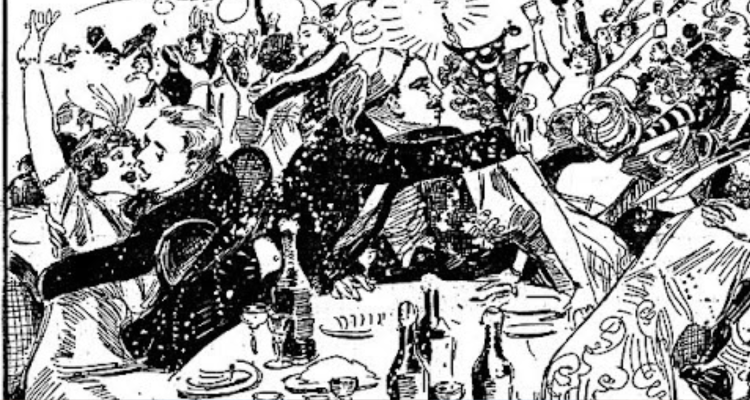New Year’s is a holiday of pure joy. You don’t have to buy anything for anyone or do anything in particular. It’s a choose-your-own-adventure kind of holiday. It’s all about looking fondly back at the year we leave behind while looking brightly to what’s next. It’s a holiday all about hope. And luck. It also happens to be one of my favorite holidays (and not just because it’s the setting for one of the best scenes in When Harry Met Sally, though, that does help). What I find most interesting about New Year’s are the many rituals people will do in hopes of making the next year a little luckier – which led me down a rabbit hole searching for some fun and funky New Year’s traditions from Wheeling and beyond!
New Year Traditions From Around the World
Traditions for bringing in luck can be found all over the world. In Spain, there’s a tradition to eat 12 grapes at each chime of the clock at midnight. Each grape is to bring sweetness in the months ahead, making it important to be mindful of which grapes are bitter. Also, if you finish all 12 by the last bell chime, you are said to be lucky in the new year!1 If you want a backup Spanish plan for luck, red underwear is said to also help you out.2 In Japan, toshikoshi soba noodles are eaten. The noodles symbolize a long, healthy life and the thinness of the noodles makes them easy to cut, symbolizing cutting off the misfortune of the previous year.3 In Italy, lentils are eaten just after the new year is rung in. The way the coin-shaped lentils grow is said to represent abundance. If you’re looking for an abundant year of travel, several Latin American countries practice the tradition of running around the block with a suitcase.4

Wheeling’s New Year Traditions
The tradition I know best though, is pork and sauerkraut. In talking to several Wheeling residents, I’m not the only one. Many folks talked about eating at least one stinky bite on New Year’s Day for luck. This comes as no surprise, as this tradition is rooted in German heritage and Wheeling was once one of the largest populations of German settlers. In fact, from 1848 to 1860, Wheeling was home to not one, but TWO, German newspapers.5 While there are several German New Year’s traditions, it seems that pork and sauerkraut have been the most enduring in Wheeling.
So, what are the significance of these two foods? Like many New Year’s traditions, sauerkraut is thought to bring wealth and good fortune – with each shred of cabbage representing a wish for money and goodness.6 Similarly, pigs are often looked to as a symbol of good luck since they root forward for their food, unable to look to the side or behind themselves – a good reminder to look ahead to the new year with optimism rather than focusing on the past.7

For those of you that didn’t grow up in a pork and sauerkraut household, thank your lucky nose! As a kid, I recall walking up the day before New Year’s — because “sauerkraut always tastes better the second day” per my mom — and immediately pulling my shirt over my nose. I hated the smell. I still do. Which may be a controversial take, as my mom loves it. So does my Pap. “It smells like going to heaven,” he said. Since pork and sauerkraut is such a popular tradition, I took some time to talk to both of them to learn what it means to them.
“We’ve been doing it for generations, it came from the old country,” my mom told me. Growing up, her family made between 200-400 pounds of sauerkraut a year. It was a whole family affair, they would get together, four generations or more, in late September to begin preparing the sauerkraut. It’s a pretty simple thing to make, just salt, cabbage, and time. They used my great-great-great-great grandfather’s tools from the 1860s, a wooden shredder and ‘stomper’, to cut and press the water out of the cabbage. It would take hours just to prep all the cabbage. My mom told me that when she and her sister were very little, they would help by literally stomping on the cabbage with their feet. She wanted me to emphasize that that is not something normally done; I wanted to emphasize how funny it was and share a blanket sorry to anyone who may have unknowingly eaten the foot cabbage!
The labor of making the sauerkraut wasn’t so bad a task, because my family had one unique way to tell if they’d used enough salt: beer. “The way we knew that we had the right amount of salt, you could take your finger and put it in the water. You take that finger and you put it into beer,” according to my Pap. If you put salt in beer, it foams up, but only once. “Because of that, you constantly had to get fresh beer. So we consumed quite a bit of beer. You had to finish out the glass and get a fresh beer every time you checked.” So I can only imagine that they all ended up quite drunk by the end of the day. About three months later, the sauerkraut was ready for New Year’s.
It’s a lot easier (and less boozy) to make pork and sauerkraut the way my mom does it now. She uses SnowFloss kraut out of a jar, because it tastes the most like what they made at home. After that, it’s pretty easy. She uses pork ribs “for the fat and bone, the bone is important for the flavor.” She layers sauerkraut, pork, and a sprinkle of caraway seeds (“because they help make you less gassy after”) into a crockpot on low for 24-48 hours, adding water if needed. And that’s it. All it takes for the luck (and smell) your New Year needs. “If you don’t eat sauerkraut and pork on New Year’s, you’ll have bad luck all year long” warns my Pap. So, opt out at your own risk.

If you choose to pass on the sauerkraut this year, get inspired by some other Ohio Valley traditions for ringing in the new year. Lots of folks I spoke with shared how they literally ‘ring in’ the new year by banging pots and pans together. They’d step outside with pots, pans, and a wooden spoon to bang up a ruckus. Some people did this to scare out the bad of the previous year, others did it just to wake the whole neighborhood in celebration. Some people even reported firing guns, to add to the cacophony. Before you go doing that, though, there was a story of a man shooting out his telephone wires and being without service for a week.
Another common tradition centered around blessing money. Folks put coins or dollars outside doors, windows, under front mats, or scattered them all around the front porch. The key to this was bringing them in after midnight to have a blessing of wealth all year long. One woman even said that they baked coins into the sauerkraut, for even extra luck if you found it. Some people also did this with bread and coal, to have good food and warmth in the new year.
No matter how you choose to celebrate—my personal tradition is a bit of glitter for luck—may your New Year be absolutely splendid. If you feel like you could use a little extra luck, though, hopefully, you’ve got a few ideas on how to make that happen!
What are your favorite New Year’s traditions? Comment below to let us know!
• Makayla Carney, a Wheeling native, is the 2023-2024 AmeriCorps member for Wheeling Heritage, where she will get to write all about the history and culture of her hometown. She has a B.F.A. in Film and Television from DePaul University in Chicago. She adores all kinds of art, a lavender latte, and the occasional performance on the Towngate Theatre stage.
References
1 Koehler, Jeff. “Green Grapes And Red Underwear: A Spanish New Year’s Eve.” NPR, 31 Dec. 2012, https://www.npr.org/sections/thesalt/2012/12/26/168092673/green-grapes-and-red-underwear-a-spanish-new-years-eve.
2 Speak, Clare. “EXPLAINED: Why Do Italians Eat Lentils on New Year’s Eve?” The Local, 30 Dec. 2020, https://www.thelocal.it/20201230/why-do-italians-eat-lentils-on-new-years-eve.
3 Kahan, Kim. “New Year’s Eve in Japan Means Toshikoshi Soba | Tokyo Weekender.” Tokyo Weekender, 28 Dec. 2021, https://www.tokyoweekender.com/art_and_culture/japanese-culture/new-years-eve-in-japan-means-toshikoshi-soba/.
4 Ciolli, Chris, and Jessie Beck. “14 Different New Year’s Traditions around the World.” AFAR Media, December 15, 2023. https://www.afar.com/magazine/new-years-traditions-from-around-the-world.
5 Allen, Bernard L. “Germans.” e-WV: The West Virginia Encyclopedia. 13 July 2023. Web. 29 December 2023.
6 “New Year’s Eve (Silvester).” German Food Guide & Directory. Accessed December 29, 2023. https://www.germanfoodguide.com/holiday-silvester.cfm.
7 Stoltzfoos, Cayla. “A History of Pork & Sauerkraut.” Stoltzfus Meats, April 13, 2022. https://www.stoltzfusmeats.com/blogs/stoltzfus-meats-blog/a-history-of-pork-sauerkraut.



